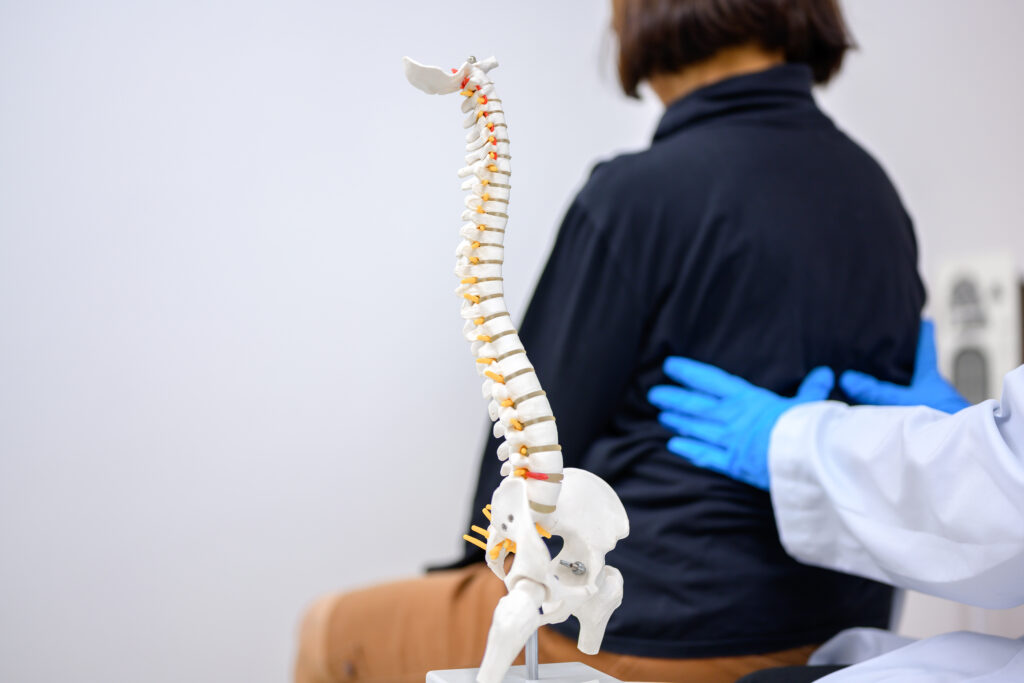The spine is central to movement, balance, and daily activities. So, when spinal injuries happen, understanding them and their treatments becomes vital. With prompt, effective medical intervention, you can prevent lasting disabilities and promote overall well-being.
Knowing the different types of spinal injuries and the available treatment options empowers those facing such conditions to make informed decisions and potentially experience a significantly improved recovery.

Cervical Spine Injuries
Injuries to the neck vertebrae—also called the cervical spine—can be very serious. This is because the cervical spine holds up your head and connects directly to your nervous system.
Depending on which nerves are affected, these injuries can cause anything from a little discomfort to severe pain, numbness, or even paralysis.
Initial treatments focus on immobilization using a neck brace or collar to prevent further injury. Pain management often involves both medication and ice or heat therapy, while rehabilitation includes a tailored physical therapy regimen designed to strengthen neck muscles and regain flexibility.
Surgeons have two main tools in their toolbox for neck injuries: fusion and disc replacement. Fusion permanently connects nearby vertebrae, stopping painful movement but also making your neck less flexible. Disc replacement, on the other hand, is designed to keep your neck mobile while still easing pain.
The good news is that, with innovative minimally invasive spine surgery Singapore, these surgeries cause less damage to surrounding tissues. This means a faster recovery and a better chance of getting back to your normal life.
Thoracic Spine Injuries
Thoracic spine injuries are less common due to the stability provided by the rib cage and interconnecting muscles, but they can be severe when they occur. Symptoms typically include sharp pain, difficulty breathing, and limited upper-body mobility.
Conservative treatments involve pain relievers and wearing a thoracic brace to stabilize the mid-back region. Physical therapy goes hand-in-hand with recovery, helping you build stronger back muscles and improve your posture for better spinal health.
For severe injuries to the thoracic spine, surgery might be needed. One option is spinal fusion, which stops any movement in the injured area to create stability. Another approach uses metal rods and screws to hold the spine in place.
Regardless of the specific surgical method employed, extensive pre-operative planning takes place to ensure these procedures minimally disrupt the patient’s ability to breathe normally and maintain overall mobility.
Lumbar Spine Injuries
The lumbar spine is frequently subjected to injury due to its role in bearing the body’s weight and facilitating movement. Common symptoms include lower back pain, sciatica, and muscle spasms.
Initial treatment typically involves rest, ice or heat therapy, and over-the-counter pain medication. Plus, physical therapy can improve strength and flexibility in the lower back. Ergonomic adjustments at work and home can also prevent further strain.
If nonsurgical treatments don’t help, minimally invasive spine surgery becomes an option. These procedures use smaller incisions and specialized tools to address problems like bulging discs or nerve pressure.
Sacral Spine Injuries
Injuries to the sacral spine can affect the lower back, buttocks, pelvic area, and legs. Common treatments include the use of pain relief medications and targeted physical therapy to alleviate pain and improve mobility.
For those who do not respond to conservative treatments, advanced options like nerve stimulation or minimally invasive surgical interventions may be necessary. These surgeries typically focus on relieving pressure on affected nerves and stabilizing the sacral area to prevent further injury.
Recovery and rehabilitation are tailored to individual needs, often involving both physical and occupational therapy to ensure functional mobility.
Spinal Cord Injuries
Spinal cord injuries require immediate and aggressive treatment due to the risk of permanent loss of function below the injury site.
Emergency treatments often include high doses of corticosteroids to reduce swelling and surgery to stabilize the spine and relieve pressure on the spinal cord. After undergoing surgery, comprehensive rehabilitation is pivotal, requiring a collaborative effort from physical therapists, occupational therapists, and psychologists, all working together to facilitate the recovery process.
Rehabilitative efforts may incorporate adaptive devices and technologies such as wheelchairs and computer interfaces to promote independence and enhance the individual’s overall quality of life during the rehabilitation journey.
Compression Fractures
Compression fractures primarily affect the elderly and those with osteoporosis. Treatment starts with managing pain through medications and may involve wearing a back brace to support the spine as it heals. Physical therapy is key after such a fracture. It helps build strength, improve flexibility, and lower the risk of future breaks.
In some severe cases, minimally invasive surgery like vertebroplasty or kyphoplasty might be needed. These procedures stabilize the fractured bone and quickly reduce pain. They involve injecting a cement-like substance into the fractured vertebrae, thereby restoring height and reducing spinal deformity.
Degenerative Disc Disease
Degenerative disc disease is a result of the aging process and involves the gradual deterioration of the discs between the vertebrae. Treatment begins with nonsurgical approaches such as physical therapy, pain management, and lifestyle modifications like diet and exercise to maintain spinal health.
When other treatments fall short, surgery might be an option. When it comes to surgical interventions, there are two primary approaches that surgeons may recommend: disc replacement or spinal fusion.
The disc replacement procedure aims to preserve mobility in the spine, whereas spinal fusion involves eliminating movement at the injured site to manage pain.
While both techniques concentrate on restoring proper function and alleviating chronic pain, the overarching goal is to maintain as much natural spinal movement as possible.

Wrapping Up
The road to recovery from a spinal injury starts with understanding the different types and the treatments available. From quick, minimally invasive procedures to more complex surgeries, the approach is chosen to perfectly fit the injury. Knowing your options and getting early treatment are vital to minimize lasting problems, improve recovery, and get you back to living a full and active life.











Leave a Reply